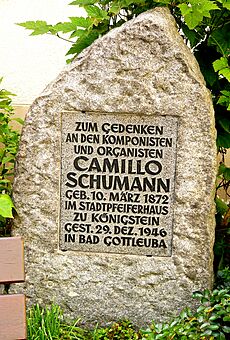Camillo Schumann facts for kids
Camillo Schumann (born March 10, 1872 – died December 29, 1946) was a German composer and organ player. He lived during the late Romantic period in music.
Contents
Camillo Schumann's Life Story
Camillo Schumann was born in a town called Königstein, Saxony. He was one of twelve children! His father, Clemens Schumann senior, was the city's music director. Camillo's mother was Camilla Ottilie.
Camillo had several talented brothers. His older brother, Georg Schumann, also became a famous composer. Another brother, Alfred Schumann, was a lead violinist for an orchestra. Clemens Schumann junior was also a violinist in a well-known orchestra in Dresden.
Early Music Lessons and Training
Camillo and his brothers started learning music from their father when they were very young. Camillo learned to play many different instruments.
From 1889 to 1893, he studied at two important music schools. First, he went to the Hochschule für Musik Carl Maria von Weber Dresden for a short time. Then, he studied at the Hochschule für Musik und Theater Leipzig. There, he learned from famous teachers like Carl Reinecke and Salomon Jadassohn.
After that, in 1894 and 1895, he continued his studies in Berlin. He attended the Royal Music Institute of Berlin.
Working as an Organist
While he was studying in Berlin, Camillo worked as a substitute organist. This meant he filled in for the main organist in several large churches.
On October 1, 1896, he got a full-time job. He became the organist at the main church, St. Georg, in Eisenach. He also played the organ at the Wartburg Chapel nearby.
In 1906, he received a special honor. He was given the title of Grand Ducal Saxon Music Director and Court Organist. This meant he was a very important musician for the Duke.
Later Life and Composing
Camillo Schumann organized many concerts in Eisenach. These concerts often featured organ music and chamber music. Sometimes, his brothers Georg and Clemens junior would perform with him. He was especially dedicated to playing the music of Johann Sebastian Bach. Bach was another famous composer who was born in Eisenach.
In April 1914, Camillo moved to Bad Gottleuba. He took on a few more church music jobs close to his new home. However, he started spending more and more time writing his own music. He wanted to focus on composing away from his official court duties.
Camillo Schumann passed away in Bad Gottleuba on December 29, 1946. He was 74 years old. His grave is still there today. In 1972, a special stone was placed in his hometown of Königstein to remember him.
Camillo Schumann's Music
Camillo Schumann wrote many different types of musical pieces. He composed for various instruments and groups. Here are some examples of the kinds of works he created:
Music for Cello
Camillo wrote several pieces for the cello, including:
- Cello Sonata No. 1 op. 59
- Cello Sonata No. 2 op. 99
Choral Works (Music for Choirs)
He also composed music for choirs to sing:
- Six cheerful songs op. 33
- Psalm of Praise op. 70
Duets (Music for Two Instruments)
Many of his pieces were written for two instruments playing together, like:
- Two Recital Pieces for Violin and Piano op. 17
- Fantasy piece for Oboe and Piano op. 31
- Three Fantasy Pieces for Clarinet and Piano op. 74
Music for Piano
Camillo wrote a lot of music for the piano. These pieces often had descriptive titles:
- Five little instructive piano pieces for young people op. 14
- Sketches from the Thuringian Forest op. 23
- The Seasons op. 56
- Two Little Instructive Christmas Fantasies op. 86
Piano Trios
He composed music for a group of three instruments, usually a piano, violin, and cello:
- Piano Trio No. 1 op. 34
- Piano Trio No. 2 op. 88
Organ Works
As an organist, Camillo Schumann naturally wrote many pieces for the organ:
- Organ Sonata No. 1 op. 12
- Organ Sonata No. 2 op. 16
- Fantasy and Fugue on "Eine feste Burg" op. 10 (A Mighty Fortress Is Our God)
- Concert Prelude and Fugue on the Choral "Nun danket alle Gott" op. 100 (Now Thank We All Our God)
Harmonium Works
He also wrote music for the harmonium, which is an instrument similar to an organ:
- Suite in F major for harmonium op. 26
- Sonata for Harmonium op. 103
Violin Sonatas
Camillo composed several sonatas for the violin, often with piano accompaniment:
- Violin Sonata No. 2 op. 40a
- Violin Sonata No. 3 op. 78


